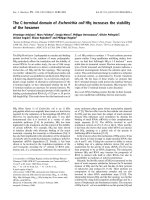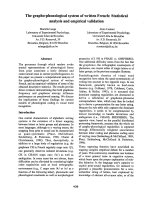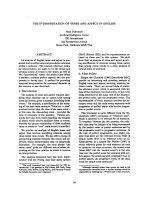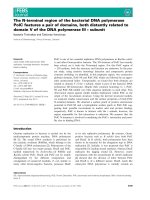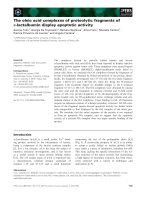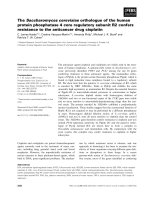báo cáo khoa học: " The global health governance of antimicrobial effectiveness" pot
Bạn đang xem bản rút gọn của tài liệu. Xem và tải ngay bản đầy đủ của tài liệu tại đây (165.84 KB, 2 trang )
BioMed Central
Page 1 of 2
(page number not for citation purposes)
Globalization and Health
Open Access
Editorial
The global health governance of antimicrobial effectiveness
Greg Martin*
Address: London School of Hygiene and Tropical Medicine, Keppel Street, London, WC1E 7HT, UK
Email: Greg Martin* -
* Corresponding author
Abstract
Antimicrobial resistance is a growing threat to public health the world over. Global health
governance strategies need to address the erosion of antimicrobial effectiveness on three levels.
Firstly, mechanisms to provide incentives for the pharmaceutical industry to develop antimicrobials
for diseases threatening the developing world need to be sought out. Secondly, responsible use of
antimicrobials by both clinicians and the animal food growing industry needs to be encouraged and
managed globally. And lastly, in-country and international monitoring of changes in antimicrobial
effectiveness needs to be stepped up in the context of a global health governance strategy.
Four and a half billion years of evolution has left the
microbes that cause disease in humans, with a remarkable
capacity for adaptation to changes in their micro chemical
environment. This month Globalization and Health pub-
lished a paper, "Antibiotic resistance as a global threat:
Evidence from China, Kuwait and the United States"
which explores the possibility of a global spread in anti-
microbial resistance (AMR) and a novel technique for
monitoring such a phenomenon. Whether or not AMR
spread will become a global phenomenon still remains to
be seen, the monitoring thereof will however be a valua-
ble exercise, (figure 1).
The problem of AMR need to be addressed on three fronts.
Firstly, on a bio-molecular level, antimicrobial develop-
ment needs to be aggressive and target aspects of the path-
ogens which are least likely to have variable phenotypes.
While research along these lines is being done, our failing
is perhaps in the pace of it. Research and development for
diseases in the poorest countries – those that are most
affected by infectious disease – is sorely lacking and inno-
vative mechanisms to provide incentives for the pharma-
ceutical industry to develop drugs which are in the global
public interest need to be devised. Public Private Partner-
ships (PPPs) have shown some promise but are yet to rep-
resent a definitive solution. It is quite remarkable that,
until last year, despite 1.5 million people dying of the dis-
ease annually, we had failed to produce a single novel TB
treatment for 30 years.
Secondly, and perhaps most importantly, mechanisms
need to be put in place to ensure responsible antimicro-
bial usage by clinicians. Overuse, under-use, poor diag-
nostic techniques and inappropriate choice of
antimicrobial account for the bulk of resistant strains
emerging world wide. The WHO has taken the lead in this
regard with its recommendations under the 'widely and
wisely' approach to AMR control.
The overuse of medication is often a response to demand-
ing patients receiving private health care, who want the
"latest" and "best" drugs that money can buy. They are
unlikely to be satisfied with the use of penicillin as a first
line of treatment for their pneumonia and are equally
unlikely to be persuaded by an explanation which
involves calculating a "greater net social utility".
Published: 25 April 2006
Globalization and Health 2006, 2:7 doi:10.1186/1744-8603-2-7
Received: 23 April 2006
Accepted: 25 April 2006
This article is available from: />© 2006 Martin; licensee BioMed Central Ltd.
This is an Open Access article distributed under the terms of the Creative Commons Attribution License ( />),
which permits unrestricted use, distribution, and reproduction in any medium, provided the original work is properly cited.
Publish with Bio Med Central and every
scientist can read your work free of charge
"BioMed Central will be the most significant development for
disseminating the results of biomedical research in our lifetime."
Sir Paul Nurse, Cancer Research UK
Your research papers will be:
available free of charge to the entire biomedical community
peer reviewed and published immediately upon acceptance
cited in PubMed and archived on PubMed Central
yours — you keep the copyright
Submit your manuscript here:
/>BioMedcentral
Globalization and Health 2006, 2:7 />Page 2 of 2
(page number not for citation purposes)
Antimicrobial effectiveness (AME) is subject to the classi-
cal economic scenario of the 'tragedy of the commons'. A
'common' good differs from a public good, in that,
although it can be accessed by everyone, it can also be
used up, i.e. it is 'rival' in consumption. This is best illus-
trated with the scenario of a field (or common), to which
all the local farmers have access. Before long, the field is
over-grazed and of little use to anyone.
It is not just clinicians who are responsible for over graz-
ing the green grass of AME. The use of antimicrobial in the
growth of cattle, poultry and fish is contributing to
increase in AMR to Enterococci and other microbes which
cause infections in humans.
Finally, global health governance strategies need to be
continually updated and implemented with a strong
emphasis on surveillance. In "Antibiotic resistance as a
global threat: Evidence from China, Kuwait and the
United States", published this month in Globalization and
Health, Zhang et al. explore the possibility of measuring
and monitoring the spread of AMR globally.
In the context of this ongoing erosion of AME and the
ominous prospect of returning to an era akin to that of the
'pre-antimicrobial', renewed and innovative efforts to pro-
mote new drug development needs to be combined with
the coordinated management of 'global common goods
consumption' and an ongoing global surveillance strat-
egy.
Competing interests
The author(s) declares that they have no competing inter-
ests


